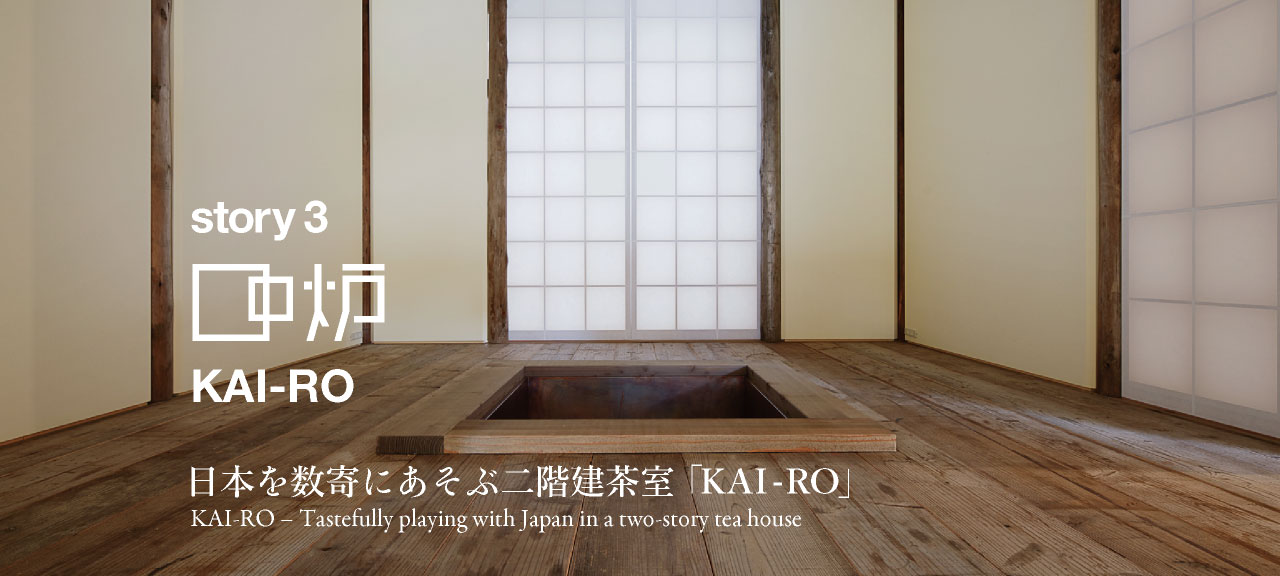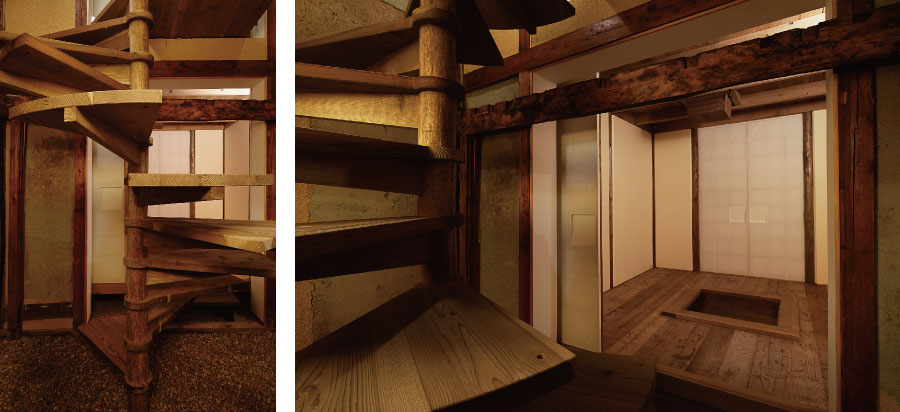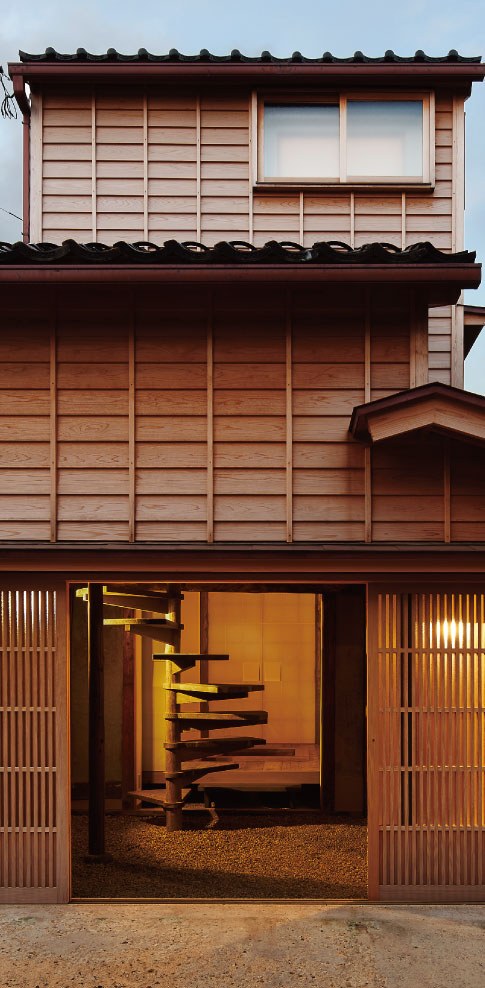

日本の「茶の湯」の歴史は奈良時代に始まったとされるが、「わび茶」の原型がつくられたのは室町時代のこと。室町中期に登場した村田珠光が連歌や禅に学びながら、それまで書院でやっていた豪華な「茶の湯」に対して、簡素な空間で心の静寂を求める「わび茶(草庵の茶)」の原型をつくった。その後、武野紹鴎を経て、安土桃山時代に、千利休が「亭主が茶を点て、客が茶を飲む」というシンプルなやりとりを極上のハレの場として大成した。
「わび茶」は、主客の一期一会を一心に演出する。長い年月をかけて磨き上げられた“もてなし”と“ふるまい”と“しつらい”には、人の身体感覚と精神世界がひそんでいる。KAIは、「わび茶」の本質を現代の感覚で捉えなおすため、茶室の何を守り、茶会の何を破り、そして茶道の何から離れるべきなのかを問い、極上のハレの場になる舞台を「KAI-RO」として表現した。
The history of Japanese cha-no-yu (tea ceremony) dates back to the Nara period, although the original form of wabi-cha was developed during the Muromachi period. Murata Juko, who appeared in the middle of Muromachi period, developed the original form of wabi-cha (Soan-no-cha), which sought tranquility of the soul in aesthetic surroundings, as opposed to the gorgeous cha-no-yu tea ceremony that had conventionally carried out in shoin drawing rooms. After passing through further evolution by Takeno Jōō, Sen no Rikyu refined the simple interaction of “the host pouring tea for the guest to drink” into the ultimate auspicious setting during the Azuchi-Momoyama period.
In the wabi-cha tea ceremony, the concept that every single encounter is never repeated in a lifetime is wholeheartedly embodied by the host and guest. Honed over many years, the concepts of omotenashi (hospitality), furumai (deportment), and shitsurai (arrangements) conceal human physical sensations and inner psychology. In order to recapture the intrinsic nature of wabi-cha with a modern feel, KAI examined what needed to be preserved in the chashitsu, what parts of the tea gathering should be deconstructed, and what should be deviated from in the tea ceremony. As a result, it developed KAI-RO as an expression of the ultimate auspicious setting.

茶室という特殊な建物に繊細かつ大胆に向き合うため、かつての茶室の構造を基本に置きながらも、現代の限られたスペースの中で提案できることは何かを徹底的に考え抜いた。
新しい茶室のカタチづくりは、俗塵を払う露地、心頭をすすぐ蹲、ワビに入る躙口、心を交える小間、あたたかみを添える炉、趣向を凝らす床の間など、それらがもたらす役割を見極め、変えないものと変えるものを丁寧に選り分ける作業から始めた。そのうえで、四畳半の広さで茶室の魅力を堪能できるような工夫を検討した。
「KAI-RO」では、寄付と待合、待合と茶室など、それぞれの場が干渉し合わないように「二階建て」という手法をとり、庭を介さずに空間の境界を設けるため「螺旋階段」を据えた。1階に半畳の囲炉裏、2階に炉と床の間をつくった。また、上下階の空間にしたことで、本来の茶室のような一方向の流れだけではなく、両方の空間を行ったり来たりして楽しめるという新しい使い方を見出した。
To delicately and boldly confront the special building that is a tea house, we thoroughly considered what can be proposed within the spatial limitations of the modern age while retaining the basic structure of the traditional chashitsu.
Creating the shape of a new chashitsu began from the work of discerning the roles of the various elements, such as the roji for dusting off earthly affairs, the tsukubai stone washbasin for cleansing one’s soul, the nijiriguchi for entering the austere atmosphere, the koma for seeking conviviality, the irori for providing warmth, and the tokonoma alcove for elaborating the setting, and carefully selecting which items should be changed and which shouldn’t. Then, we examined ways to ensure that guests can fully appreciate the appeal of the chashitsu in a room measuring four and a half tatami mats.
KAI-RO has adopted a two-story structure to ensure that the yoritsuki (entrance room), machiai (waiting room), and chashitsu (tea-ceremony room) do not interfere with each other. Moreover, it has installed a spiral staircase to establish a boundary between spaces without using a garden. There is a hearth of half-mat size on the first floor, while the second floor comprises a fireplace and a tokonoma. By arranging these spaces on different floors, we have devised a new way to enjoy not only the conventional one-direction flow of the chashitsu, but the fun of moving between the spaces.

「KAI-RO」のもう一つの特徴は、動かないことが前提だったこれまでの茶室に対して、どこへでも自由に動く茶室であることだ。動くというのは車輪がついているという意味ではない。組み立てて終わりではなく、解体して部材の持ち運びができ、好きな場所で再び組み立てられるということである。
基本的な構造には、螺旋階段を含めて組み立て式の技術を用いた。KAI-KIやKAI-SOUでも展開したように、亭主の趣向によっては、柱をアクリルと木などの異素材の取り合わせでつくってもよいし、アルミ製の意匠棚を持ち込むこともできる。また、室内につくった茶室なので、壁は内装として独立しており、簡単に取り変えることができる。
部材は、あえて手に入りやすい直径10センチの足場丸太と幅24センチの足場板を採用した。庭師さんが高い木の剪定で利用するもので、いずれも手頃な値段の材だ。ただ、茶室というあるレベルの品格を保つための「KAI-RO」ではその素材感の出し方にこだわった。
会期中は、さまざまな人が寄りつどい、遊び楽しむ場となる。茶・花・書・連歌から、ポップでパンクなイベントまで、いろいろに混ざった出来事をおこしたい。
One more characteristic of KAI-RO is that, whereas conventional tea houses were predicated on being immovable, this tea house can freely move anywhere. This doesn’t mean that tea house is equipped with wheels; however, rather than simply being assembled and completed, it can be disassembled so that the parts can be carried to another place and put back together again.
The basic structure including the spiral staircase utilizes assembly technology. As is also deployed in KAI-KI and KAI-SOU, depending on the owner’s taste, pillars can be a combination of different materials such as acryl and wood, while aluminum artistic shelves can also be introduced. Moreover, since this tea house is constructed indoors, the walls are independent interior furnishings that can be easily replaced.
As for the parts, easily obtainable scaffold poles of 10 centimeters in diameter and scaffold boards measuring 24 centimeters across have been adopted. Such parts, which are used by gardeners for pruning tall trees, are reasonably priced. However, effort was made to evoke a sense of texture in KAI-RO worthy of the dignified nature of a tea house.
During the campaign period, this will be a place where various people can gather and enjoy themselves. Whether it be the tea ceremony, flower arranging, writing or linking renga poetry, we hope to stage a variety of events ranging from pop to punk.
Speaker: Shiro Miura Interviewer: Kanako Izumi
語り手 : 三浦史朗 書き手 : 和泉佳奈子



| サイズ scale | |
|---|---|
| 【1階】 | 1st floor |
| 床面積 8.2㎡ | Floor Area 8.2㎡ |
| 2864×2864mm | 2864×2864mm |
| 天井高 2351mm | Ceiling height 2351mm |
| 【2階】 | 2nd floor |
|---|---|
| 床面積 8.2㎡ | Floor Area 8.2㎡ |
| 2864×2864mm | 2864×2864mm |
| 天井高 2165mm | Ceiling height min:2165mm |
| 【階段】 | Stairs | 1820×h2821mm | 1820×h2821mm |
|---|
| 仕様 specification | |
|---|---|
| 【柱】 | Pillar |
| 桧 足場丸太 | Japanese cypress&cedar Scaffold poles |
| 【壁/襖】 | Walls/Sliding doors |
| 鳥の子紙/両面張り | Torinokogami (a variety of Japanese paper)/Pasted on both sides |
| 【天井】 | Ceiling |
| 杉 足場板 t30 | Japanese cedar Scaffold Boards t30 |
| 【1階、床】 | 1st floor,floor |
| 杉 足場板 t30 | Japanese cedar Scaffold Boards t30 |
| 【2階、床】 | 2nd floor,floor |
| 畳 | Tatami mats |
| 金額・納品 Price/delivery |
|---|
| 応 問い合わせ Inquiries |
